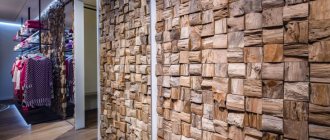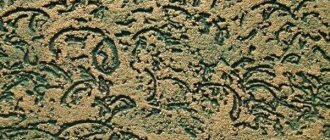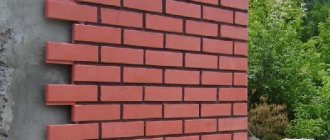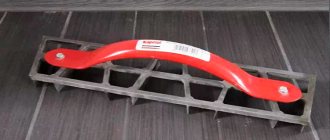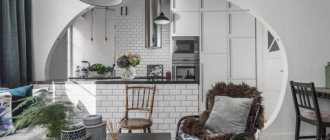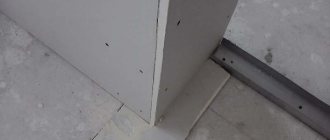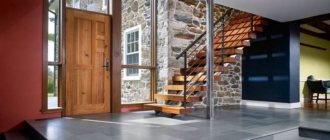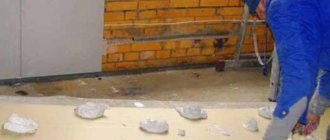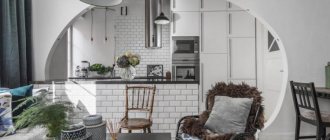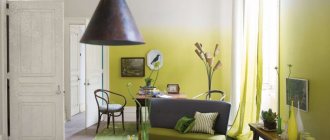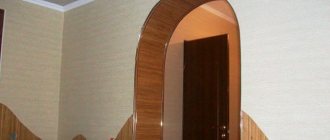Redecoration involves changing the decorative design of a room. When transforming an apartment or house, you need to take into account all the nuances. Corners are a problem area for most materials, because these areas are subject to mechanical stress. To obtain a high-quality result, pay attention to the decorative finishing of the corners of the walls in the apartment.
Module
In what cases is finishing necessary for corner elements?
List of cases when it is necessary to use a decorative corner:
- Improving the visual perception of finishing. This works like a frame on artwork.
- Requirement to protect the finish from damage. Damage is caused by children, pets, and also due to negligence, for example, when playing sports.
- Finishing is done to protect against contamination. This can happen due to accidental touching.
- In situations where the design project involves framing with finishing.
- Joining of materials not intended for corner transition (Plastic plates, timber).
- Placing pieces of furniture that require creating an organic interior around.
Appearance
Finishing the corners of the ceiling
Ceiling joints require lighter material than walls. Commonly used are polyurethane and polystyrene skirting boards, which are quite cheap, easy to cut and have an attractive appearance. To cut foam baseboards, use a thin, well-sharpened stationery knife.
Corner screen in the living room
Chinoiserie style cabinet in the corner of the office
If the room has smooth corner lines, then for cutting it is best to use a miter box - a special tool with templates for cutting at 90° and 45°. Before applying glue, carefully measure the correct cut of the baseboard. The ceiling is an element of the house that will definitely be noticed, and shortcomings will be visible. In this case, it is better to simply putty the microscopic deviations.
Corner bench made of wood in the hallway
Sofa in the decor of the staircase corner
If you don’t have a miter box, it doesn’t matter. To correctly cut the corners, follow the instructions:
- Take a small strip of plinth, a hard, well-sharpened pencil, a ruler and a stationery knife or saw, depending on the material used.
- Attach the prepared piece of plinth to one of the corners of the ceiling and mark a line along the edge on the ceiling, do the same in the opposite corner, marking the point where the corners meet.
- Further, based on the calculations obtained, it will not be difficult for you to trim the corners evenly and join them. This works on both outside and inside corners.
Corner rack with dishes in the kitchen
Floor lamp and chair in corner decor
Types of decorative corners on walls
A variety of corner design options are available. In construction stores you can find the following modules:
- Arched.
- Under ceramic tiles.
- External and internal solutions.
Attention! Joining elements is quite difficult, so you should purchase elements separately for each corner. It is allowed to use elongated products and subsequently cut off the edges.
Application area
Arched
The elements are often pre-curved and made of plastic. Available in a wide range of colors and textured options.
For ceramic base tiles
The ends of square modular designs are especially often used in corners. Corners are formed on window openings, on kitchen “work aprons”, and at countertops.
For external and internal corners
Among each variety there are corresponding subtypes. They differ from each other in the direction of bending and overall dimensions.
Textured corners
Textured models are the same plastic, but specially painted to resemble a natural material or a special surface. For example, plastic allows you to create a wood border on a budget and visually frame it with stone. The element does not acquire any special properties from its texture.
Wooden
Wood is a material that serves as a source for many construction products, including corners. The material is environmentally friendly, noble in color perception, durable. There are also several mounting options available for it, each of which is quite effective.
Attention! Wood often needs to be additionally coated with varnish.
Corners for ceilings and baseboards
Designed for a smooth transition between vertical and horizontal surfaces.
Natural stone corners
Natural materials are relevant due to their safety and noble texture. The stone has an increased price. Brings elegance and nobility to the apartment.
Often the stone module is used only on surfaces decorated with stone. It should be noted that a module that does not overlap with other finishing elements looks ridiculous.
Artificial stone corners
Like the natural equivalent, artificial stone is mounted with glue, but can be processed with metal fasteners. It has similar textures, but is more elastic and cheaper.
Attention! Some consistencies of “liquid nails” allow you to fix artificial stone on the wall, but additional reinforcement is required.
Universal corner finishing system
The Alta-Decor collection also includes universal finishing of the corners of the house facade, which can be used with absolutely all Alta-Profile finishing materials - horizontal, vertical and foam siding, block house and facade panels. In addition, such a system can be installed with other types of finishing - for example, on a plastered facade.
The corner finishing system consists of a base and overlay trim elements in three different sizes. By combining them, you can achieve interesting design effects. There can be a lot of options, and the choice depends solely on the taste of the owner and the desired result.
Protect corners from damage
In an apartment there is always a risk of chips and dents that form defects on the wall. Angles are a common victim of such changes, as they are usually more tactilely close.
With texture
A decorative element covering a corner from the outside or inside helps protect it. We are talking about any type of product. The plastic element also becomes a barrier that holds the structure together and prevents it from crumbling or collapsing.
Specialized products cope with this task more successfully. They are usually made of rubber materials; silicone options are widely used.
Interesting! If there is a small child in the apartment, the use of silicone pads is important. They do not guarantee absolute safety, but they significantly reduce the risk of injury from falls.
Visual impact on the interior
Finishing is primarily aimed at complementing the overall appearance of the interior. Therefore, it is performed before furniture, the final, final stage.
Finishing
In some rooms this is necessary. These are cases when the walls are decorated with plastic panels, ceramic tiles, and timber. This finish creates an unsightly corner transition that requires careful linear masking.
Interesting! Decorating nuances and imperfections is important in situations where the wallpaper meets at a corner.
The presence of a frame is interpreted by the design project of the apartment. In such projects, a certain texture (for example, wood) or color (natural, white) usually predominates. Creating an angular outline makes the room more impressive, more expressive, and in some situations allows you to focus attention on the walls and pieces of furniture.
Wide corner
Protective “frames” help create a safe, futuristic atmosphere. This is probably why they are irrelevant in classically styled apartments. This is much better suited to more modern solutions, such as high-tech and modern.
Finish options
The difficulty of finishing corners lies not only in the fact that they must be even. The fact is that these sections of the walls are often subject to shock loads, so it is necessary to provide them with sufficient strength.
Currently, there are several ways to solve this problem. The choice of method depends on the type of wall decoration, which can be as follows:
The most common wall finishing options
Next, I will tell you how to finish the corners in each individual case.
Option 1: plastered or plasterboard walls
If the walls are plastered or covered with plasterboard, then special plaster corners are usually used to finish the corners. They come in two types:
- Aluminum perforated. Used for finishing flat areas;
Aluminum perforated corner is quite durable and reliable
- Arched. Made of plastic. Their main feature is their increased flexibility, which allows them to be used for finishing curved surfaces;
The arched profile can be glued to curved surfaces
The corners are glued with plaster or putty at the stage of rough finishing of the walls. During their installation, be sure to use a level. This allows you to install them strictly vertically or horizontally.
It must be said that this solution is used both for internal walls and facades. But, most importantly, this finishing of the outer corners of the house allows not only to level them, but also to protect them from mechanical damage.
Price:
| Corner type | Price in rubles (3 m) |
| Aluminum | From 25 |
| PVC | From 30 |
| PVC with reinforcement mesh | From 50 |
| Arched PVC | From 50 |
Please note that all prices are current as of Spring 2021.
The joints of PVC panels can be decorated with special profiles
Option 2: finished with PVC clapboard
Recently, PVC (polyvinyl chloride) lining, which is simply called plastic panels, has become very popular. Most often this material is used in the following rooms:
- Bathrooms;
- Kitchens;
- Hallways.
If the walls are finished with plastic, the corners can be decorated in the following ways:
- Using profiles. This is the simplest method, the essence of which is to use corner profiles. They are installed on the lathing using a level, just like plaster corners.
As a rule, profiles are fixed to the sheathing using a stapler. Then the panels are simply inserted into special grooves;
Scheme of bending PVC panels
- By bending the panels. To bend a plastic panel with your own hands, you need to cut its inner side along the fold line. It is even advisable to cut a thin strip, as shown in the photo diagram above.
Before bending, it is advisable to heat the front side, for example, using a hairdryer.
Price. The price of guides for PVC panels starts from 25-30 rubles per 3 m (standard length).
Option 3: finished with wooden paneling
Not so long ago, when finishing walls with clapboards, the boards for corner joints were cut and adjusted. At the same time, the remaining cracks were filled with putty. Nowadays, you can purchase a special wooden corner to decorate corners.
Wooden corners allow you to quickly and easily design lining joints
You can secure it to the lining using window nails. The only thing is that it is advisable to bite off the nail heads so that they are invisible.
It must be said that in this way you can finish not only external, but also internal corner joints.
Price. The cost of wooden corners averages about 50 rubles per linear meter.
There are special guide corners for siding
Option 4: facade finished with siding
Many beginners are interested in how to decorate the corners of the house on the facade? As I said above, perforated plaster corners can be used for wet facades.
If the facade is sheathed with siding or other facade panels, you should use special additional elements, which are usually sold complete with panels.
The corner serves as a fastening element for siding, and also performs a protective and decorative function.
Such corners perform several functions at once:
- Provide fixation of panels;
- Design the joint of the panels;
- Protect the ends of the panels from mechanical loads;
- Serve as guides for siding.
In fact, installing siding corners is similar to installing guides for PVC lining. They are also mounted on the sheathing, but not with a stapler, but with self-tapping screws. In this case, a level must be used.
The ends of lumber in a wooden house require protective treatment
Option 5: wooden walls
At first glance, there is no need to decorate the corners of a wooden house from the outside, since they themselves look quite attractive and are quite durable. However, not everyone knows that the ends of lumber are the areas that are least resistant to moisture and rot.
To protect them, special sealants and impregnations are used for the corners of a wooden house.
Price. Below are the most popular formulations and their costs:
| Brand | Price in rubles |
| ELCON-T, 1 kg | 220 |
| NEOMID TOR PLUS, 5 l | 990 |
| Wood Master, 10 l | 590 |
You can use compounds for the ends of lumber not only outside, but also inside a wooden house.
Corners can be decorated in an apartment with decorative corners
Option 6: wallpapered or finished with liquid materials
Above, I have already talked about the rough method of finishing plastered walls. Finally, let’s look at how the decorative finishing of such walls is done.
So, there are two most common ways to solve this problem:
- Decorative overlays . Finishing external corners in an apartment involves installing PVC or polyurethane corners.
In the photo - polyurethane lining
These products can be made to look like wood or even look like an expensive baguette. The latter are usually made of polyurethane. They look rich and are used in classic interiors;
Decorative stone allows you to decorate corners beautifully and unusually.
- Decorative stone . In this case, the corners are covered with decorative stone, which can be made of plaster, cement or even natural stone.
It must be said that this method can be used not only for interior walls, but also for the facade.
The instructions for installing decorative corners require removing the finishing coating in the area where they adjoin the wall. This is especially true for heavy polyurethane linings.
Price. Below is the cost of some materials for decorating corners:
| Materials | Cost in rubles per |
| Camelot (brick tiles) 1 m2 | 750 |
| Artel (natural decorative stone) 1 m2 | 1990 |
| Artstone (artificial decorative stone) 1 m2 | 945 |
| Ideal (PVC cover) 2740 mm | 75 |
| Decomaster (polyurethane pad) 2400 mm | 1780 |
Materials for finishing corners in an apartment
There are types of profiles for framing an apartment. They differ in material and price values. There are both budget options and elite, expensive ones.
To external corners
When developing a design, you need to pay attention not to the price parameter, but to the direct combination with the overall appearance.
Corner options
Plastic panels
Plastic has a wide selection of colors and the ability to apply coloring to achieve an original design. There are also camouflage options. Cheapest idea.
Range
Transparent silicone corners
Designed to ensure security in the apartment. Installed on painted surfaces, on wallpaper.
Decorative rock
An effective solution that requires strict adjustment of the remaining elements in the room. Relevant for living rooms and bedrooms decorated in the spirit of medieval buildings or classical styles.
The material is heavy and requires careful fastening.
Drywall
Cheap, lightweight, suitable for decorating interiors with stucco molding and cladding ceiling elements. Beautifully emphasizes the columns. Available in different shapes, the standard has antique bevels.
How to decorate the corners of walls in an apartment
First, let's look at several ways to decorate external corners. They are not protected by anything and due to frequent interaction with other objects (friction, impacts, etc.) they quickly become unsightly: wallpaper peels off, paint sticks, cracks and chips appear, light walls at the joints darken, become dirty, and dark ones show abrasions. To prevent such consequences, there are many high-quality methods, and most importantly, stylish options for finishing external corners. A huge selection of finishing materials allows you to decorate the walls in the most unusual solutions.
Corner decor
Corner cabinet decor
Corner decor
Plastic corners for walls (colored and white)
One of the most practical ways to decorate external corners in an apartment is with plastic corners. They are often used in conjunction with perforated metal profiles, which make it possible to give an ideal geometry to an uneven corner at the stage of leveling the surface for painting or wallpapering. This “duet” will certainly make the corners stronger and, of course, visually improve them. Plastic corners perform their functions perfectly even without mounting profiles, namely:
- fully protect the corners at the joints of walls from various marks, chips and scratches;
- hide existing problem areas;
- mask the transition from one type of finish to another, zone the room;
- eliminate gaps and cracks between wall panels;
- improve the appearance and refresh wall decor.
Soft corner in the kitchen
Corner decor
Shabby chic corner decor
White corners are the most widespread because they look neutral in almost any interior. Multi-colored options (including those reproducing different textures) look original and can be used as an element of any style in the interior, and those contrasting with the color of the walls will divide the room into zones.
Corner office
Corner decor
Corner decor with a pattern
But most often the corners are selected to match the partitions or from similar raw materials. The main materials from which products used for decorative purposes are made:
- polyvinyl chloride;
- polystyrene;
- polyurethane;
- silicone;
- tree;
- metal.
Corner drawers
Corner decor
Corner decor with shelves
The most popular is the PVC corner. Reasons for its popularity:
- easy processing of the material (can be cut to the desired size without any problems);
- flexibility (suitable for arches or other plastic shapes and curved surfaces);
- easy installation (you can glue it quickly, even with your own hands, it lasts a long time);
- wide color palette;
- democratic price.
Corner decor
Corner decor
Decor of corners in the nursery
Its use is also very popular in the bathroom at the junction of the plumbing with the wall. It is impossible to do without installing decorative plastic corners in areas of constant physical activity (for example, vestibules, window and door slopes). Also, the appearance directly depends on their size, shape and texture. The following means are used for fixation:
- liquid Nails;
- acrylic sealant;
- silicone sealant;
- glazing nails;
- self-tapping screws
Corner decor
Corner decor in country style
Corner decor in the bedroom
It is important to remember that each material has its own method of connection to the surface. It is necessary to take into account its combination with the wall covering (for example, plastic corners are not suitable for covering a wall made of wood).
Corner decor
Corner decor with candlestick
Corner decor
Decorating corners in an apartment with decorative corners is one of the most practical and convenient ways.
Corners made of any material can continue the baseboard on the walls
Corner decor
TV corner decor
Universal flashings for windows and doors
Door and window trims are designed to tightly close a certain hole, gap or potentially vulnerable spot (for example, a seam, a joint between surfaces). They not only eliminate the appearance of the gap, but also prevent drafts. Strips can be internal or external. For maximum efficiency, you can use both options: the first will be responsible to a greater extent for practicality, the second - for aesthetics. Universal flashings are typically used for windows and doors. They come from various materials:
- plastic;
- tree;
- metal.
Decoration of corners with a wooden panel
Corner decor
The choice of product depends on the material of the surface to be finished. The color scheme and texture of the decorative item should be based on the parameters and features of your window profile.
Window strips are used as protection for polyurethane foam at the junction of the frame and the opening (since the foam does not tolerate ultraviolet radiation and becomes unusable over time), and also for its intended purpose - as additional protection from the wind. For a finished look at the junction of the window frame and the slope, a silicone-coated strip is used. When installing, a special self-adhesive layer is applied to the reverse side (otherwise, self-tapping screws or self-tapping screws are used). Strips are often used as a waterproofing agent in the bathroom. This item is durable, stable, unpretentious to climate and humidity.
Corner decor with an armchair
Corner decor
Wooden corners
Decorating external and internal corners with wooden objects is very popular. Wood is the most environmentally friendly material for corners of all types with increased strength characteristics. Most often the products are used to decorate the corners of door and window openings and walls. But recent design ideas have made the corner in demand for all kinds of decorative solutions, so today they can be used regardless of the wall covering. Their combination with laminate or furniture made of the same type of wood is welcome.
These models are somewhat more expensive than plastic ones, but the price is justified by their appearance and quality.
Kitchen corner decor
Corner decor under the stairs
Finishing corners with natural stone
Stone is one of the oldest building materials and does not lose popularity today. Such cladding in the interior always looks expensive and creates a feeling of a slight touch of antiquity, which gives the room a special charm.
Corner decor
Decorate corners with flowers
Finishing with natural stone is not a cheap pleasure, as it is an environmentally friendly and safe material, in addition, it is ultra-strong and durable. In the modern world, filled with technical devices and low-quality plastic consumer goods, people sometimes want to feel a little closer to nature. Finishing with natural stone, even in small quantities (for example, in the corners of an apartment), will contribute to a wonderful sense of unity.
Corner table decor
Corner decor
It is the joints of the walls that are subject to greater pressure from the owners, so finishing with natural stone will protect them from damage 100%. It is important to consider that some types of raw materials require periodic care (washing, brushing).
The disadvantages include the fact that if used incorrectly, framing corners with natural stone can introduce heaviness into the space. But if used correctly, even an internal joint, separated into a separate zone, will be very cozy and neat.
Corner decor
Corner decor
The following species are used to decorate corners in an apartment:
- sandstone;
- slate;
- limestone;
- dolomite.
The following types are used mainly for the exterior cladding of a building, however they can be found (in exceptional cases) in finishing corners inside an apartment:
- marble;
- granite;
- river and sea pebbles.
Natural stone for finishing can be in its original form (chipped, torn natural relief) or processed. Many subsequent factors depend on this (for example, whether damage will be noticeable on it, style, and, of course, cost). It is not recommended to paint the stone.
Many types of masonry are used - die, plateau, castle, rondo, assol, etc.
Corner decor
Corner decor
Finishing corners with artificial stone and brick
Today, decorative stone finishing is in great demand. There are many reasons for this, and they are quite justified:
- artificial stone protects corners from mechanical damage no worse than natural stone;
- the material is light, comfortable and practical, does not require special care (since it is smoother, it is enough to simply wipe it with a damp cloth);
- With the help of modern technologies, it is possible to recreate almost any type of stone with amazing accuracy, within a smaller budget;
- looks stylish and modern, not so heavy.
Artificial stone can be combined with almost all types of materials, so it can be successfully combined with other design solutions in a variety of styles, since the shape, color, relief and size can be completely individual. It is more suitable for painting and is easier to use at the finishing stage.
Corner decor
Corner decor with a wall slide
Depending on the manufacturing technology, there are several types of decorative stone:
- rubble (analogous to boulders and pebbles);
- chipped (imitates unprocessed rock);
- sawn (clear geometry, unpolished surface);
- mosaic (imitation of many small stones, customized to a specific composition);
- brick (imitates various types of brickwork);
- tiled (similar to natural polished stone).
And not so long ago, another completely unusual species appeared - fantasy. It has a complex shape and color that is not found in nature.
Also, natural brick is often used as a decorative finish. However, it cannot be classified as a natural stone, but it is not synthetic either.
Corner decor
Corner decor
More often, corner cladding is used in the hallway. This is due to the fact that the most dust and dirt accumulate in this room, but you can get rid of them quite easily with this finish (using only water). If you decide to use household chemicals to clean the surface, it will not damage the material at all.
Types of decorative stones can be combined to create unusual images and ornaments.
Artificial stone finishing of internal corner and opening
Corner decor
Protection of corners with moldings and MDF panels
Molding is an overlay decor in the form of a three-dimensional strip; it gives any item a more complete, expressive and sophisticated look. Most often moldings are made of plastic:
- polyurethane;
- polystyrene;
- polystyrene foam
These materials are resistant to external influences and are characterized by an affordable cost. Also found from:
- gypsum;
- marble;
- tree.
Corner decor in the living room
Corner decor
They are more expensive and not as practical as modern plastic ones, so they are more often used in the design of historical interiors.
Decorating with a three-dimensional plank is especially often used to protect corners at the junction of walls and ceilings, floors. We are very familiar with ceiling and floor moldings - the so-called baseboards. The decor for the corners of the ceiling can be within a certain style and combined with other decorative elements (for example, stucco molding, bas-relief).
Corner moldings for framing external corners are used if ordinary plastic or wooden corners do not fit the style of the room.
The combination of corner moldings, MDF wall panels and decorative stucco molding in the interior
Covering corners with tiles and mosaics
In some rooms, walls can be tiled (in the bathroom, in the kitchen). At the junction of surfaces, special inserts are used - trims, which play the role of corners. They are attached to the tiles using silicone or acrylic sealant. There is also such a type of tile as corner tiles, it will allow you not to interrupt the masonry, but to make a smooth transition from one surface to another.
Corner decor with chandelier
High-quality and stylish mosaic masonry will decorate the walls no worse than any other type of decoration. Materials can be synthetic or natural. Corner joints in any of these cases cannot necessarily be framed with decorative corners; it is enough to place the ends of the tiles on the most visible (front) side onto the surface of the less visible (side) part of the mosaic cladding. Mosaic can be glass or plastic. You can decorate joints in this way in the form of any pattern or ornament.
Decorating corners in an apartment: how to decorate a room with corners
There are quite a lot of factors that encourage the use of decorative corners in the rooms of a residential apartment. Among them, for example:
- The material from which the surface is made. It makes no sense to cover it with clapboard for decoration with a plastic module. You need to choose a special color scheme and a suitable texture.
- Finish color. Experiments are always interesting, but a bright red element in a pastel room will seem funny and unsuccessful.
- General style of a solid interior. Let's say the room is made in a classic, antique spirit. The cladding made of polyurethane and stainless steel will give an absurd look. Shaped polyurethane is unsuccessful in minimalism and hi-tech.
- Room assignments. The corner will help secure the room if required - for example, if a child lives in the apartment, it is enough to purchase silicone elements. This will preserve the health of the little resident and the integrity of the structures.
Angle design
Wallpaper design options
When wallpaper on different walls is decorated in the same shade, a finish of a color similar to the overall tone is used. In the case of different colors, the selection depends on the desire to show emphasis. The decoration is directed towards the main wall.
Solution for corners on slopes: the better way to seal corners in an apartment
The module is usually used in the color of the slope. Usually the finishing of slopes is white, so this color is used. The module is selected in width that will cover the end of the panel. Fasteners are made at right angles, slightly bent for even application.
Interesting! Extension is carried out when laying on a flat surface or using a wide pipe.
Option for decoration under wallpaper
Wallpapered walls must be decorated in accordance with the design. Light elements are used, such as PVC parts, natural wood, polyurethane and plastic.
It is desirable that the corner profile for wallpaper has a light shade. This is required in order to protect the finished repair from the appearance of defects.
When wallpaper is glued to a corner, they are pressed with one decorative element. They are the same size and extend to the inside.
Cladding the corners of a house with a plastered facade
The Alta-Profile corner finishing system is suitable not only as a complement to siding and facade panels, but also with plastered facades. In this case, you need to cut off the mounting shelf for fastening from the mounting base profile, and secure this profile to the wall using self-tapping screws. Next, the installation of overhead elements is carried out in the same way as they are installed when finishing a house with siding or facade panels.
Such a system will become an attractive accent if the house is decorated with decorative plaster, and will also help strengthen the most vulnerable areas of the facade.
How decorative corners are attached
In order to perform fastening, different types of adhesive compositions are used. Glue is considered the best option, since the slots from metal fasteners will need to be additionally decorated, which is not always possible in relation to the design and expected appearance of the finished surface.
Nails, self-tapping screws and the like are used in cases where the material for making the corners is quite heavy and does not allow the use of an adhesive composition.
What to glue plastic ones to?
It is possible to decorate a room with plastic using the following fastening methods:
- Sealants based on silicone, acrylic and similar viscous emulsions.
- "Liquid nails", construction PVA.
Solid versions of fastening elements are not used.
After applying the composition, you need to fix the angle. Fixation is carried out using masking tape, ordinary office tape. The drying process takes about 12 hours. The exact time depends on the specific material, but it is advisable not to remove the fixation during this period.
Interesting! The best result in decoration is shown by the “liquid nails” PVA construction adhesive option. Some products of this composition cope without fixation.
Finishing corners from a wooden base
The tree needs to be protected - a varnish or resin base is used. The natural texture does not withstand damage.
Attention! It is also possible to give the wood a different shade. This will be facilitated by special stains, dyes, and colored varnishes.
It is also possible to use glue here when it comes to the interior decoration of the apartment (for example, decorating a corridor). After fastening to a metal part, you need to close the left slot. Closing is done with special plastic modules. It is permissible to fill the hole.
Material
How to glue a plastic corner on wallpaper
The opinion that work on wallpaper is carried out with other materials is erroneous - the same types of adhesives are used as for painted corners. The nuances in the work are added by the need to wait for the glue to dry completely; it is important to make sure that the coating is stable.
It is necessary to monitor the material for leaks. Decorating an apartment implies accuracy in all nuances, so clean parts of the wallpaper are covered with tape or covered with film.
Cosmetic renovation is a multi-level procedure that involves attention to every detail of the apartment. Among the details, the design of corners is an important stage, which emphasizes the effectiveness of the coating on the walls, ceiling and floor. It is useful to study the theory in this matter if you have any construction experience.
Basic installation rules: how to finish corners?
The corner finishing system is installed in much the same way as siding and facade panels. Since corners are more often subject to increased loads than walls, it is preferable to mount them on a metal sheathing.
A flat sheathing profile is used to install the corner finishing system.
When finishing corners, you must follow the following rules:
- The first step is to install the “mounting base” profile. To do this, 3 screws are screwed into special holes on each side.
- Overhead elements of different sizes are attached to the base in random order. They are inserted into special grooves and snap into place.
- You need to think about the installation procedure in advance, since the finishing elements are only suitable for one-time use.
- No special tools are used during installation.
- Siding and facade panels are inserted into a special gap between the sheathing and overhead elements.
- If the thickness of the panels is greater than the gap, then they are secured using a mounting shelf, which is bent on each side and secured in the appropriate clamps.
